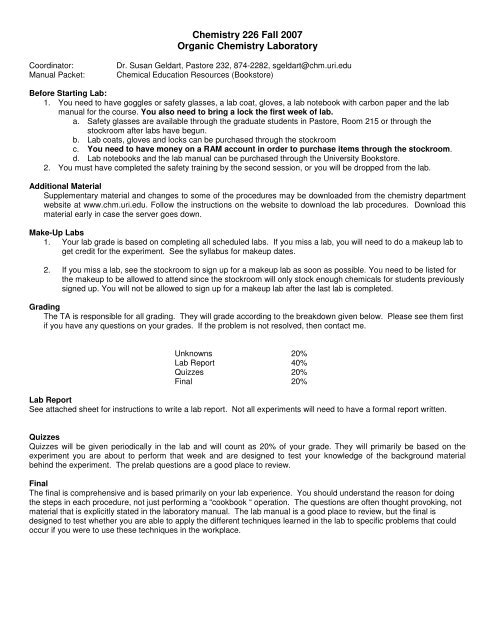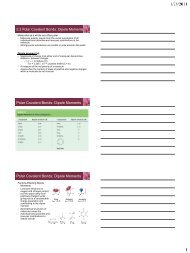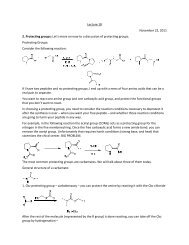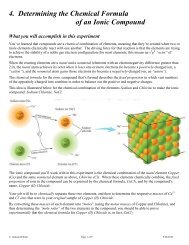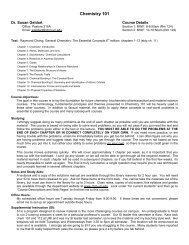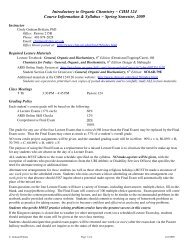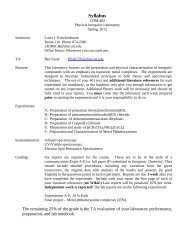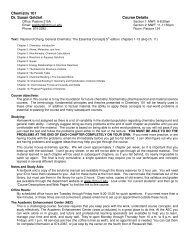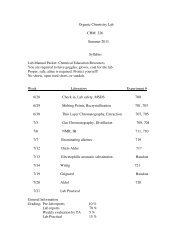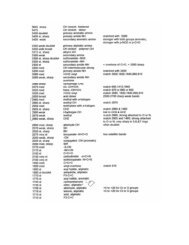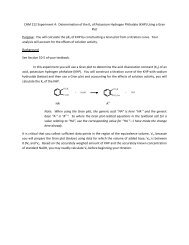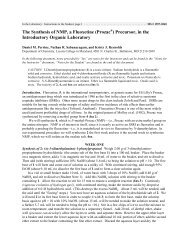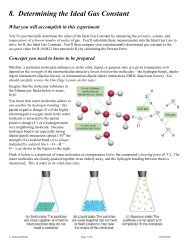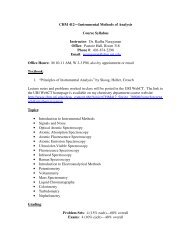Chemistry 226 Fall 2007 Organic Chemistry Laboratory - URI ...
Chemistry 226 Fall 2007 Organic Chemistry Laboratory - URI ...
Chemistry 226 Fall 2007 Organic Chemistry Laboratory - URI ...
Create successful ePaper yourself
Turn your PDF publications into a flip-book with our unique Google optimized e-Paper software.
<strong>Chemistry</strong> <strong>226</strong> <strong>Fall</strong> <strong>2007</strong><strong>Organic</strong> <strong>Chemistry</strong> <strong>Laboratory</strong>Coordinator:Manual Packet:Dr. Susan Geldart, Pastore 232, 874-2282, sgeldart@chm.uri.eduChemical Education Resources (Bookstore)Before Starting Lab:1. You need to have goggles or safety glasses, a lab coat, gloves, a lab notebook with carbon paper and the labmanual for the course. You also need to bring a lock the first week of lab.a. Safety glasses are available through the graduate students in Pastore, Room 215 or through thestockroom after labs have begun.b. Lab coats, gloves and locks can be purchased through the stockroomc. You need to have money on a RAM account in order to purchase items through the stockroom.d. Lab notebooks and the lab manual can be purchased through the University Bookstore.2. You must have completed the safety training by the second session, or you will be dropped from the lab.Additional MaterialSupplementary material and changes to some of the procedures may be downloaded from the chemistry departmentwebsite at www.chm.uri.edu. Follow the instructions on the website to download the lab procedures. Download thismaterial early in case the server goes down.Make-Up Labs1. Your lab grade is based on completing all scheduled labs. If you miss a lab, you will need to do a makeup lab toget credit for the experiment. See the syllabus for makeup dates.2. If you miss a lab, see the stockroom to sign up for a makeup lab as soon as possible. You need to be listed forthe makeup to be allowed to attend since the stockroom will only stock enough chemicals for students previouslysigned up. You will not be allowed to sign up for a makeup lab after the last lab is completed.GradingThe TA is responsible for all grading. They will grade according to the breakdown given below. Please see them firstif you have any questions on your grades. If the problem is not resolved, then contact me.Unknowns 20%Lab Report 40%Quizzes 20%Final 20%Lab ReportSee attached sheet for instructions to write a lab report. Not all experiments will need to have a formal report written.QuizzesQuizzes will be given periodically in the lab and will count as 20% of your grade. They will primarily be based on theexperiment you are about to perform that week and are designed to test your knowledge of the background materialbehind the experiment. The prelab questions are a good place to review.FinalThe final is comprehensive and is based primarily on your lab experience. You should understand the reason for doingthe steps in each procedure, not just performing a “cookbook “ operation. The questions are often thought provoking, notmaterial that is explicitly stated in the laboratory manual. The lab manual is a good place to review, but the final isdesigned to test whether you are able to apply the different techniques learned in the lab to specific problems that couldoccur if you were to use these techniques in the workplace.
Guidelines for Writing a Lab ReportIntroduction (5 points)Purpose: Summarizes purpose of labFormat: ParagraphIncludes: Reasons for doing the lab, ex: uses in industry, etc.Length: 3-5 sentencesTips: Summarize introduction given in the lab in your own wordsExperimental Procedure (10 points)Purpose: States how you will be accomplishing the goals of the introductionFormat: ParagraphIncludes: Chronological description of procedures used in the labLength: Depends on the length of the proceduresTips: Summarize procedure in lab manual in paragraph formData and Results (20 points)Purpose: Show data or observations collected the data in the lab and if appropriate, a table of lab results.Format: Data tables; Neatly organized with and comments on observationsCopies of instrumental analyses and carbon-copies of data from labbookIncludes: Carbon-copies of all data recorded in class, if not neatly written, include both CC data and aneatly typed data table.Length: Depends on labTips: Write your data neatly in your lab book and it will not need to be retypedPost Lab Questions (40 points)Purpose: Solidify concepts learned in labFormat: Numbered in paragraph formIncludes: Answers to all questionsLength: Depends on the labConclusions (20 points)Purpose: Restates your introduction and describes if experiment was successfulFormat: ParagraphIncludes: 1. Sources of error in experiment, do not use “human error”2. Explanation of whether you feel your experiment was successful or not3. Implications of method and procedures on industry, etc.Length: 5-8 sentencesTips: Look back at the introduction and decide if you met the goals of the experiment, state mistakesthat were made, give a few sentences on commercial uses for the procedures. Make sure toinclude specific sources of error that resulted in decreases in yield, experiment not working, etc.Lab Technique (5pts)Five points of each grade on a lab report will be based on your lab technique for that experiment. The points will beawarded on cleanliness of your lab bench area and hood, how careful you are when performing your experiment,maintenance of communal chemical areas and coming to lab prepared and on time.


